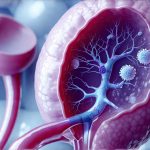The interplay between the urinary system (uro-) and the immune system is increasingly recognized as critical for overall health. Traditionally viewed as separate entities, we now understand that these systems are deeply interconnected, constantly communicating and influencing each other. This bidirectional relationship, termed uroimmune modulation, impacts not only renal function but also systemic immunity, impacting susceptibility to infection, autoimmune responses, and even cancer development. Disruptions in this delicate balance can contribute to a wide range of diseases, from chronic kidney disease and urinary tract infections to autoimmune conditions like lupus nephritis and systemic sclerosis. Understanding the mechanisms behind uroimmune modulation is therefore paramount for developing novel therapeutic strategies that target both immune dysfunction and urological health simultaneously.
The focus historically has been on the immune system’s response to the urinary tract, largely in the context of infection or transplantation. However, recent research demonstrates a more nuanced picture: the urinary tract actively modulates the immune system. This modulation occurs through several pathways, including the release of alarmins from damaged tissues, the presentation of antigens by specialized cells within the kidney and bladder, and the secretion of immunomodulatory molecules like cytokines and chemokines. Furthermore, the microbiome residing in the urinary tract – once thought to be sterile – is now known to play a significant role in shaping local and systemic immune responses. Drug-activated pathways offer exciting possibilities for harnessing this modulation, shifting from simply suppressing unwanted immune reactions to actively steering the immune system towards beneficial outcomes within the urological context.
The Role of TLRs in Uroimmune Modulation
Toll-like receptors (TLRs) are a family of pattern recognition receptors expressed by both immune cells and non-immune cells within the urinary tract, including urothelial cells, renal tubular epithelial cells, and fibroblasts. They serve as sentinels, detecting pathogen-associated molecular patterns (PAMPs) from invading microbes or damage-associated molecular patterns (DAMPs) released from injured tissue. Upon activation, TLRs initiate intracellular signaling cascades leading to the production of pro-inflammatory cytokines and chemokines – essentially sounding an alarm that recruits immune cells to the site of injury or infection. However, this initial inflammatory response is not always beneficial; chronic TLR activation can contribute to tissue damage and fibrosis in conditions like interstitial cystitis/bladder pain syndrome (IC/BPS) and glomerulonephritis. Targeting specific TLRs with drugs represents a promising strategy for modulating uroimmune responses.
Several therapeutic approaches are being explored to modulate TLR signaling. These include:
– Small molecule inhibitors that directly block TLR activation.
– Strategies to enhance the expression of negative regulators of TLR signaling, like SOCS1.
– Modulating the microbiome to reduce PAMP load and subsequently TLR activation.
Importantly, selective targeting is crucial; broadly suppressing all TLRs could compromise systemic immunity. Recent research focuses on identifying TLR subtypes most relevant to specific urological conditions and developing therapies tailored to those targets. For example, in IC/BPS, where TLR4 appears to play a key role in driving chronic inflammation, selectively blocking TLR4 signaling shows promise in preclinical models.
The complexity of TLR signaling also lies in its cross-talk with other immune pathways. Activation of TLRs often leads to the production of type I interferons (IFNs), further amplifying the immune response but also potentially contributing to autoimmunity. Drugs that target downstream signaling molecules common to both TLR and IFN pathways, such as JAK inhibitors, are being investigated for their ability to dampen inflammation in a variety of urological autoimmune diseases. This highlights the need for a systems-level understanding of uroimmune modulation to design effective and targeted therapies.
Modulation of the Urinary Microbiome & Immune Responses
The urinary microbiome, once considered sterile, is now recognized as a dynamic ecosystem influencing immune function within the urinary tract. Advances in sequencing technologies have revealed diverse microbial communities residing in the bladder, kidney, and urethra, even in healthy individuals. These microbes impact immune development, barrier integrity, and susceptibility to infection. Dysbiosis, or an imbalance in the microbiome, has been linked to a range of urological conditions, including recurrent urinary tract infections (UTIs), IC/BPS, and potentially even kidney stone formation.
Interventions aimed at restoring microbial balance – such as probiotics, prebiotics, and fecal microbiota transplantation (FMT) – are emerging as potential therapeutic strategies for uroimmune modulation. Probiotics introduce beneficial bacteria into the gut or urinary tract, while prebiotics provide nutrients to support their growth. FMT involves transferring fecal matter from a healthy donor to restore a diverse microbiome in the recipient. While still early stages of research, studies suggest that these approaches can modulate immune responses by altering microbial metabolite production and influencing TLR signaling. For instance, specific bacterial strains have been shown to produce short-chain fatty acids (SCFAs) with anti-inflammatory properties.
However, several challenges remain. The composition of a “healthy” urinary microbiome is still poorly defined, and the optimal strategies for restoring balance are under investigation. Furthermore, FMT carries potential risks, including transmission of pathogens. More research is needed to understand the long-term effects of microbiome modulation on uroimmune function and to develop targeted interventions that minimize adverse effects. Personalized approaches based on individual microbial profiles may be necessary to achieve optimal outcomes.
Harnessing Urothelial Cell Immunomodulatory Capacity
The urothelium, the specialized epithelium lining the urinary tract, is not merely a passive barrier but an active participant in immune regulation. Urothelial cells express a variety of immunomodulatory molecules, including cytokines, chemokines, and MHC class II proteins, enabling them to interact directly with immune cells. They can also present antigens, initiating or modulating T cell responses. This intrinsic immunomodulatory capacity makes the urothelium an attractive target for drug-activated pathways.
Drugs that enhance urothelial cell expression of programmed death ligand 1 (PD-L1) are being investigated as potential therapies for bladder cancer and other urological autoimmune diseases. PD-L1 is a key immune checkpoint inhibitor that suppresses T cell activity, preventing excessive inflammation or autoimmunity. By upregulating PD-L1 on urothelial cells, drugs can dampen local immune responses and promote tolerance. Similarly, targeting signaling pathways within urothelial cells to increase the production of immunosuppressive cytokines like IL-10 could offer another approach for modulating uroimmune function.
However, manipulating urothelial cell immunomodulatory capacity requires careful consideration. Excessive suppression of immunity could increase susceptibility to infection or allow tumor cells to evade immune surveillance. Therefore, strategies aimed at achieving a delicate balance between immune activation and suppression are crucial. Furthermore, the specific expression patterns of immunomodulatory molecules on urothelial cells can vary depending on disease state and individual patient characteristics, highlighting the need for personalized therapeutic approaches.
The Future of Uroimmune Modulation
Drug-activated pathways offer exciting possibilities for treating a wide range of urological diseases by modulating the complex interplay between the urinary and immune systems. This emerging field requires further research to fully elucidate the underlying mechanisms driving uroimmune dysfunction and to develop targeted therapies that address specific disease states. The future likely lies in personalized medicine approaches, tailoring interventions based on individual patient characteristics, microbial profiles, and genetic predispositions. Advances in genomics, proteomics, and metabolomics will be essential for identifying biomarkers that can predict treatment response and optimize therapeutic strategies. Furthermore, the development of novel drug delivery systems targeted to the urinary tract will enhance efficacy while minimizing systemic side effects. Ultimately, a deeper understanding of uroimmune modulation promises to revolutionize the management of urological diseases and improve patient outcomes.





















